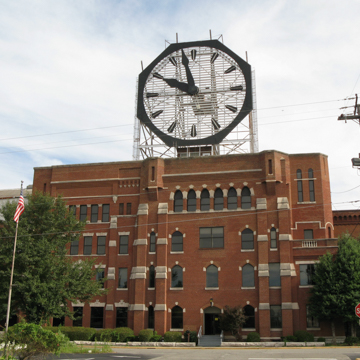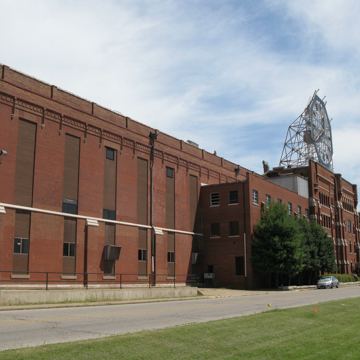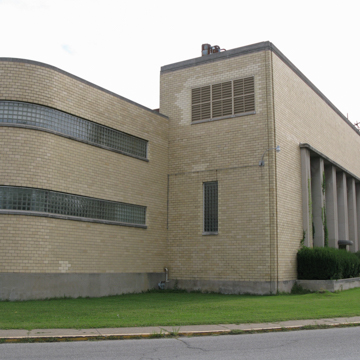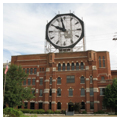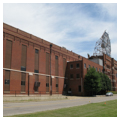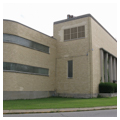You are here
Colgate–Palmolive Factory
The Colgate-Palmolive Factory is located in Clarksville, Indiana, adjacent to the western limits of the city of Jeffersonville and across the Ohio River from Louisville, Kentucky. The complex was initially developed as the second location of the Indiana State Prison, and was in operation from 1847 until its conversion into the Indiana Reformatory in 1897. The Reformatory occupied the site until 1924, when the buildings were remodeled into a regional factory for Colgate and Company, later known as the Colgate-Palmolive Company, which occupied the site until 2008. Throughout its history, the complex has comprised a series of interconnected buildings (now more than 24) within a parcel of land not open to the general public. The public face of the institution was presented by its perimeter buildings and structures, which tend to feature the most carefully articulated exteriors.
The fifty-year period spanning the period between the prison’s construction to its 1897 conversion into a reformatory traced the arc of nineteenth-century prison reform in Indiana, with the system evolving from its initial focus on vindictive justice and the exploitation of cheap labor to a modern system focused on the reform of inmates and their reintroduction to society as productive citizens. The Indiana Reformatory focused its efforts on rehabilitating convicts between the ages of 16 and 30 by preparing them for productive life as law-abiding citizens rather than punishing them. This reflected the influence of the national prison reform movement and the first time that the facility had operated under the premise set forth in the 1851 state constitution.
The earliest prison buildings, now demolished or concealed by later construction, were built between 1842 and 1847 and were designed by Indianapolis architect John Elder (1785–1851), a prominent designer of public buildings around the state during the 1840s. Significant construction work between 1891 and 1901 shaped the exterior appearance of the prison while providing more adequate accommodations for inmates. These projects transformed the plain exterior into one rich with polychrome Gothic Revival and Romanesque design elements, giving the complex a castle-like appearance and reinforcing its place as a civic landmark of Jeffersonville and Clarksville. The Louisville architectural firm of Clarke and Loomis (Charles Julian Clarke and Arthur Loomis) is believed to have been responsible for much of this transformation. Building No. 1, the Guard House and Administration Building of the Indiana State Prison, forms the complex’s primary street facade. Originally erected in the 1840s, the facade was rebuilt in 1893–1894 to harmonize with the new prison wall; the building was expanded by additions in 1899–1900. The building suffered extensive damage in a 1918 fire and its interior was rebuilt by Colgate during the 1920s.
By 1900, the institution had evolved into a modern reformatory complete with an ever-growing number of trade schools and programs intended to reform the inmates while providing them with the skills to seek a productive, honest livelihood upon release. In 1850 most of the State Prison’s inmates were farmers and were expected to return to manual labor in a rural environment. By 1900, the Indiana Reformatory focused on the preparation of its inmates for skilled work in an increasingly urban, industrial Indiana. The Reformatory’s programs continued to expand through the remainder of this period, reflecting an increasing range of skills suited to the state’s early-twentieth-century economy. Between 1899 and 1911, however, the Indiana Reformatory was at the forefront of the eugenics movement, implementing the first eugenic sterilization program in the United States, promoting the first statewide eugenics law (1907), and campaigning for compulsory eugenic sterilization laws across the country. This approach, which was based on pseudoscience and scientific racism, was deemed unconstitutional by the Indiana Supreme Court in 1921, although it was replaced by a new eugenics law in effect from 1927 to 1974.
When the Indiana Reformatory relocated to a new facility at Pendleton, Indiana, in 1921, the New Jersey–based Colgate and Company, manufacturers of soaps, toothpaste, and other household cleaning products, purchased the Reformatory complex for conversion to a new central manufacturing plant. Initial remodeling in 1923–1924 included modifications to numerous existing prison buildings with only one new structure built. The opening of Colgate’s new Jeffersonville Plant in 1924 provided the company with a centrally located facility with easy rail access to all of North America.
The Colgate Company erected a massive clock atop the roof of Building No. 1, making the plant a significant and highly visible local landmark for Clarksville, Jeffersonville, and Louisville. Originally built in 1906 for Colgate’s Jersey City plant, where it faced across the Hudson River toward New York City, the clock was designed by Colgate engineer Warren Day and was built by the Seth Thomas Clock Company for Colgate’s 1906 centennial celebration. The octagonal shape was inspired by Octagon Soap, one of the company’s most successful products. The clock was moved to Indiana and illuminated as part of the official opening of the Jeffersonville Plant. Its 40-foot-diameter face is supported by an open steel structure. The hour hand is 16 feet long and weighs 500 pounds and the minute hand is 21 feet long and weighs 640 pounds; both feature integral counterweights. The face is illuminated by neon lights around the perimeter, at the five-minute tick marks, and at the perimeter of the hands.
In 1928, Colgate merged with the Palmolive-Peet Company to form the Colgate-Palmolive-Peet Company (the name “Peet” was dropped in 1953). The evolution of Colgate-Palmolive and its products, from the 1928 merger to the debut of iconic postwar brands like Ajax scouring cleanser in 1947, reflected the growth and expansion of consumer culture in the United States during the interwar and post–World War II periods. Rising demand for the company’s cleaning and personal hygiene products ensured continued growth throughout the Great Depression. The post–World War II economic boom created a period of unprecedented wealth and consumerism running from the late 1940s through the 1960s. American companies like Colgate-Palmolive faced little international competition from Europe, where industries and infrastructure had to be rebuilt following wartime destruction. The good wages and quality benefits enjoyed by Colgate-Palmolive’s union employees during this period reflected national trends of high union membership during the postwar period. High rates of union membership gave organized labor the power to negotiate for wages and benefits, boosting the quality of life for employees and contributing to the rise of affluence in communities like Clarksville. These trends reinforced the ability of workers’ households to take part fully in the consumer culture of the postwar period.
The company expanded the Jeffersonville plant during the 1940s, with several new structures designed by Albert Kahn, Inc., of Detroit, the preeminent industrial architecture firm in the United States. The Colgate-Palmolive projects were identified as Kahn project No. 1895, with more than thirty projects running through 1989, most occurring before 1960. In 2008, Colgate closed its Jeffersonville plant. The facility was sold in 2011 to a development group.
References
“$105,600 for Reformatory.” Indianapolis Star, December 24, 1919.
“Bids For a New Cell-House.” Courier-Journal(Louisville, Kentucky), July 14, 1893.
Bishop, J. Leander. A History of American Manufactures from 1608 to 1860. Vol. III. Philadelphia: Edward Young and Company, 1868.
Bodenhamer, David J. “Criminal Punishment in Antebellum Indiana: The Limits of Reform.” Indiana Magazine of HistoryLXXXII, no. 4 (December 1986).
Clark, Perry R. “Barred Progress: Indiana Prison Reform, 1880-1920.” Master’s thesis, Indiana University, 2008.
“Colgate Buys Reformatory.” Indianapolis Star, April 21, 1921.
“Colgate plant expansion announced.” Glass Packer, Vol. 20, 1941.
Fillebrown, W. Y. “The Jeffersonville Plant.” The PulseII, no. 3 (March 1931).
“John Elder Collection, 1820-1908.” Manuscript and Visual Collections Department, Indiana Historical Society, Indianapolis, Indiana.
Kahn, Albert, Archives. Albert Kahn Associates, Inc., Detroit, Michigan.
Kramer, Carl E., and Mary Kagin Kramer. This Place We Call Home: A History of Clark County, Indiana.Bloomington: Indiana University Press, 2007.
Largent, Mark A. Breeding Contempt: The History of Coerced Sterilization in the United States.New Brunswick, NJ: Rutgers University Press, 2011.
Pisciotta, Alexander W. Benevolent Repression: Social Control and the American Reformatory-Prison Movement.New York: New York University Press, 1994.
Rimke, Heidi, and Alan Hunt. “From sinners to degenerates: the medicalization of morality in the 19th century.” History of the Human Sciences15, no. 1 (2002).
Sharp, H. C. “Rendering Sterile of Confirmed Criminals and Mental Defectives.” Proceedings of the Annual Congress of the National Prison Association.Indianapolis: Wm. B Burford, 1907.
Sharp, Harry C. “The Indiana Plan.” Proceedings of the Annual Congress of the American Prison Association.Indianapolis: Wm. B. Burford, 1909.
Stern, Alexandra. Eugenic Nation: Faults and Frontiers of Better Breeding in Modern America. Berkeley: University of California Press, 2005.
Stern, Alexandra Minna. “We Cannot Make a Silk Purse Out of a Sow’s Dear: Eugenics in the Hoosier Heartland.” Indiana Magazine of History103, no. 1 (March 2007).
Tumulty, Charles J. “The History of the Indiana State Prison.” The PulseIII, no. 3 (March 1931).
Writing Credits
If SAH Archipedia has been useful to you, please consider supporting it.
SAH Archipedia tells the story of the United States through its buildings, landscapes, and cities. This freely available resource empowers the public with authoritative knowledge that deepens their understanding and appreciation of the built environment. But the Society of Architectural Historians, which created SAH Archipedia with University of Virginia Press, needs your support to maintain the high-caliber research, writing, photography, cartography, editing, design, and programming that make SAH Archipedia a trusted online resource available to all who value the history of place, heritage tourism, and learning.

